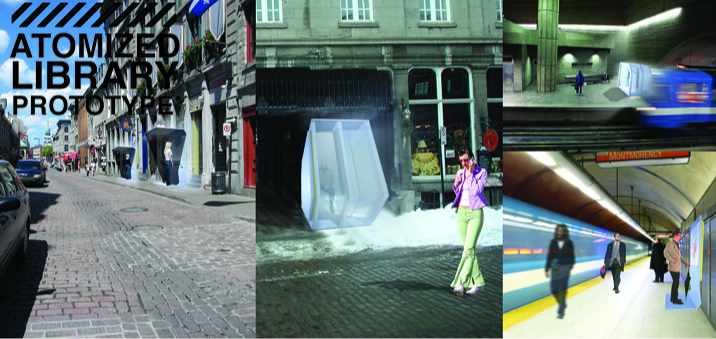note Note générale
The Library as a World Wide Web of Spaces
Cet article est d’abord paru dans la revue Argus, vol. 40, no. 1 (août 2011).

For their studio project at the California College of Arts last year, architecture students Duncan Young and Bret Walters created a new model for libraries in the information age. Released from the burden of storing actual physical books, large libraries could become smaller information spaces distributed throughout the urban space.
I asked them a few questions about their Atomized Library concept. The interview covers questions such as the value of smallness, the « world wide web of spaces », the ever-changing role of librarians, and Montréal!
I love the idea of very small libraries distributed throughout the urban space. However, in the library world, we still often see very large central libraries amongst a network of medium-size libraries, all of them clearly larger than the atomized library model that you present. Why do you think the idea of very small distributed libraries would be better suited to the information age?
The idea of “atomization” is a recent development that we see all around us. It is the product of an evolution of technology that has enabled a freedom of information that is unprecedented, and hardly tapped in terms of its potential. The role of the library in this context needs to be reconsidered in a way that embraces the new way in which we work, study, and play. As a central institution, the traditional library lacks flexibility and the ability to adapt to a quickly changing landscape of technology and user needs. The atomized library becomes a plural entity; in a sense, the city and the library become indiscernible, the city becomes the library.
I understand this would be a global network of libraries, in contrast with usual regional or municipal networks. What new possibilities do you think a global network of compatible libraries could offer? Could we imagine a « world wide web of spaces »?
The Internet is a perfect example of the power we can yield as a society when given the ability to connect across borders, cultures, and classes. If the library becomes a global network of connected spaces, the possibilities are endless. Our project seeks to capitalize on all the potentials inherent in billions of people sharing knowledge through a common system that encourages learning regardless of their location in the world.
Your posters present the notion of algorithmic deployment ”à la Google”. Does it mean that the geographic position as well as the specific services of each space would evolve dynamically to follow changing needs in the local population? Do you think it is possible to develop architectural projects that offer this kind of flexibility?
Our proposal utilizes the power of the algorithm to develop deployment strategies in a constantly evolving dialogue of data. The algorithm would use information such as population size, literacy, economic demographics, etc. to determine the geographic location and specific services of the atomized spaces. The idea is similar to the one used in search engines such as Google; the user determines the outcome. The network becomes user defined, shaped by the constantly evolving population. The architecture of this concept is proposed as one of flexibility with an ease of construction that allows it to manifest within days.
What would be the role of librarians in this network?
There are several layers to this question. In essence we see the role of the librarian expanding and becoming more dynamic. Not only would librarians continue within the more traditional library system (which we do not suggest to eliminate), but there would be new opportunities to specialize in site-specific roles. With digital media, downloading a book or journal is quite automated and would generally not require the physical interactions or one to one communications. However, people being people, there will always be a need for personalized help and direction, especially in research areas. Digitization of the world’s literary resources would vastly expand available resources, and as those resources become available, we see specific expertise needs expanding. That may mean exchanges happen over chat screens or screen sharing, but the knowledge is still being shared on a personal basis.
One of our ideas which has caused some consternation is our ‘librarian’ unit which is the most densely placed installation of our matrix. Some have interpreted this as a computer replacement for a human librarian. On the contrary, it is simply an information center linked to all the ‘spaces’ of the Atomized Library, a type of local mapping system of available sites, activities, and seminars tying together the main libraries, as well as the new Atomized spaces.
Do you think this concept could be applied in today’s world, where most readers still use printed books? Do you see projects like this one happening in the near future?
Yes, we definitely see this being applied in current times. A book being available digitally is a fairly new concept, but a rapidly expanding technology. One only has to look at the new devices such as the iPad or the Kindle sales to see this. Initially, some people might use these devices to only read journals, magazines, newspapers, and current releases, opting for traditional books for either favourite readings, or for larger format book types. However as resources dwindle, we think society will find just how luxurious a printed piece of paper is. Eventually it is inevitable that production quantities will be lowered, and the pricing of printed materials will raise. Not only will this drive people to use the digital editions, but also in the instances where they crave the tactile and physical essence inherent in a book, they will continue to visit the main library branches.
I noticed the use of Montréal on the first poster as an example for algorithmic deployment. Any story to share about the choice of Montréal?
Duncan and I initially investigated three major cities: Sao Paulo, Montréal, and Randstad to see how differing types of urban life would affect our ideas. We used Montréal as a study city for many various factors. Montréal has huge diversity and an acceptance for new ideas while still maintaining h4 personal identities within the population. Being one of the older port cities in the Americas, it has unique influences and traditions. We were drawn to the juxtapositions of new and old: decay, tradition, and new vitality all of which are inherent to this city. Each piece of the Atomized Library is an Architecture of opportunity and Montréal has incredibly diverse opportunities to exploit: parks, railways, overpasses, abandoned warehouses, water frontage, and alleys.
bookmark Terme(s) relié(s)
Carnet(s) relié(s)
 file_copy
9 notes
file_copy
9 notes
Textes de Vincent Chapdelaine sur les bibliothèques
file_copy 9 notesAuteur·trice(s) de note
Contacter l’auteur·triceCommunauté liée
Bibliothécaires engagé·es pour le bien commun
Plus d’informationsPublication
11 août 2011
Modification
24 janvier 2024 07:38
Visibilité
public

